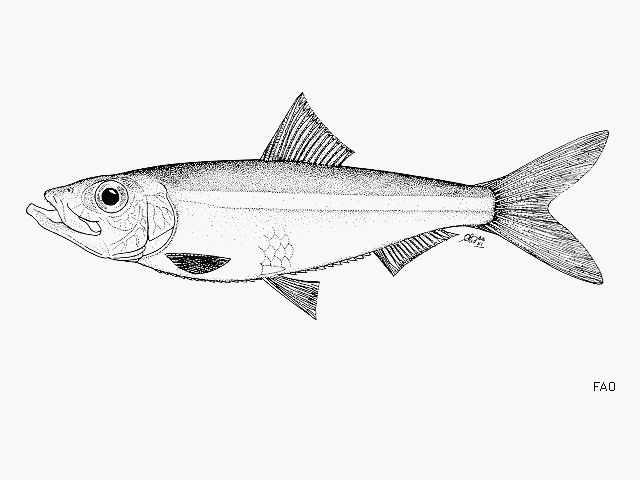|
Dorsal spines (total): 0-0; Dorsal soft rays (total): 15-18; Anal spines: 0-0; Anal soft rays: 18-21; Vertebrae: 42-44. Diagnosis: Body moderate, sometimes deep, its depth 25% of standard length or more; 13-18 pre-pelvic and 8-10 post-pelvic scutes, 1-2 scutes before pectoral fin origin, first pre-pectoral scute as long as, or smaller than, following scutes without ascending arms; lower jaw strongly projecting, with strong canine teeth at symphysis; pre-maxilla with 2-4 strong backward-pointing canine teeth on each side behind outer row of pre-maxillary teeth; lower gillrakers 16-19, shorter than corresponding gill filaments; anal fin with 18-21 rays; silver stripe along flank (Ref. 188, 54749, 81269, 81631). It resembles Odaxothrissa ansorgii, which has more gillrakers, 22-33 vs. 16-19; and Pellonula vorax, which lacks canine teeth in the upper jaw and has longer gillrakers, equal in length to gill filaments vs. shorter (Ref. 188, 54749).
Description: Body moderate, sometimes deep, depth 25% of standard length or more (Ref. 188, 2263). Caudal peduncle longer than deep (Ref. 2263). Snout longer than eye diameter (Ref. 2263). Lower jaw strongly projecting; pre-maxilla with 2-4 strong canine teeth on each side; maxillary extending to below anterior 1/3 of eye (Ref. 2263, 54749). First gill arch with 24-28 gillrakers; 16-19 gillrakers on the lower limb and 8-9 on the upper limb (Ref. 2849, 54749, 81269, 81631). Dorsal fin with 15-18 rays, its origin slightly before or behind base of pelvic fins; anal fin with 18-21 rays; pectoral fin with 12-15 rays; pelvic fin with 7-8 rays (Ref. 2849, 81269, 81631). Cycloid scales; 43-46 scales in a longitudinal series, 14 in transverse series (Ref. 2263, 3032, 54749). With 13-18 pre-pelvic and 8-10 post-pelvic scutes; pre-pectoral scutes present, 1-2 scutes in front of pectoral fin origin, first pre-pectoral scute as long as, or smaller than, following scutes without ascending arms (Ref. 188, 2849, 54749, 81269, 81631). Number of vertebrae 42-44; with 23-25 abdominal vertebrae and 20-21 caudal vertebrae (Ref. 54749, 81269, 81631).
Colouration: Alcohol-preserved specimens have the same colour as those of Odaxothrissa ansorgii: generally varying from light yellow-brown to grey yellow-brown; operculum, longitudinal stripe and ventral region silvery coloured or much lighter (Ref. 2849, 54749, 81269, 81631). |
| Found in rivers and streams, also in the man-made Lake Volta, but only in the most riverine parts (Ref. 188). It feeds on small fishes, including its own juveniles, and aquatic insects (Ref. 188, 2246). Possibly migrates upstream to breed (Ref. 188). It enters artisanal fisheries, but catches are small (Ref. 188). |
